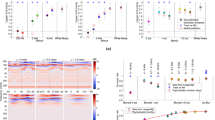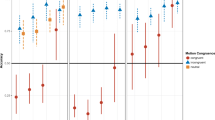Abstract
The perceived final position of a moving object usually seems to be displaced in the direction of motion. This displacement effect, termed representational momentum, has been reported for both visual and acoustic targets. This study investigated whether representational momentum in the auditory modality depends on oculomotor behavior during target presentation. In a dark anechoic environment, subjects localized the final position of a horizontally moving acoustic target (continuous noise) by using a hand pointer. Subjects were instructed to pursue the acoustic target with their eyes, to maintain central gaze direction, or to fixate a central visual fixation point. Forward displacements of the perceived final target position occurred irrespective of the eye-movement condition. This result is not consistent with previous findings in the visual modality indicating a reduction of forward displacement for continuously moving targets with fixation. It is suggested that factors other than oculomotor behavior are the source of representational momentum in spatial hearing.




Similar content being viewed by others
Notes
In the “frozen-action” experiment, a still photograph of an object in motion is presented, followed by a second picture, which is either forward or behind the direction of motion. Subjects are asked to indicate whether the second picture is different from the first. The effect of representational momentum becomes manifest in an increased reaction-time delay when the second picture is forward the direction of motion (e.g. Freyd 1983).
The shift in remembered position of stationary peripheral targets toward the center is consistent with a similar bias found in memory for peripheral visual targets toward the fovea (e.g. Mateeff and Gourevich 1983; Sheth and Shimojo 2001; Kerzel 2002b), although the origin of this foveal bias and the spatial compression in sound localization might be different.
Similar movements of the eyes have been described in a related study in which subjects localized the final positions of a moving visual target (Mitrani et al. 1979). Interestingly, even after these movements back, the gaze was still directed to a point displaced up to several degrees in the direction of motion with respect to the actual point of disappearance. However, it seems difficult to compare this finding and the present results directly because of profound differences in the experimental settings—the studies differed not only in target modality but also in, e.g., localization method and direction of motion.
References
Blauert J (1997) Spatial hearing: the psychophysics of human sound localization. MIT Press, Cambridge, MA: MIT Press
Finke RA, Shyi GCW (1988) Mental extrapolation and representational momentum for complex implied motions. J Exp Psychol Learn Mem Cogn 14:112–120
Freyd JJ (1983) The mental representation of movement when static stimuli are viewed. Percept Psychophys 33:575–581
Freyd JJ, Finke RA (1984) Representational momentum. J Exp Psychol Learn Mem Cogn 10:126–132
Freyd JJ, Finke RA (1985) A velocity effect for representational momentum. B Psychonomic Soc 23:443–446
Freyd JJ, Jones KT (1994) Representational momentum for a spiral path. J Exp Psychol Learn Mem Cogn 20:968–976
Freyd JJ, Kelly MH, DeKay ML (1990) Representational momentum in memory for pitch. J Exp Psychol Learn Mem Cogn 16:1107–1117
Futterweit LR, Beilin H (1994) Recognition memory for movement in photographs: a developmental study. J Exp Child Psychol 57:163–179
Getzmann S, Lewald J, Guski R (2004) Representational momentum in spatial hearing. Perception 33:591–599
Halpern AR, Kelly MH (1993) Memory biases in left versus right implied motion. J Exp Psychol Learn Mem Cogn 19:471–484
Hubbard TL (1990) Cognitive representation of linear motion: possible direction and gravity effects in judged displacement. Mem Cognit 18:299–309
Hubbard TL (1994) Judged displacement: a modular process? Am J Psychol 107:359–373
Hubbard TL (1995a) Environmental invariants in the representation of motion: implied dynamics and representational momentum, gravity, friction, and centripetal force. Psychon Bull Rev 2:322–338
Hubbard TL (1995b) Auditory representational momentum: surface form, direction, and velocity effects. Am J Psychol 108:255–274
Hubbard TL (1997) Target size and displacement along the axis of implied gravitational attraction: effects of implied weight and evidence of representational momentum. J Exp Psychol Learn Mem Cogn 23:1484–1493
Hubbard TL, Bharucha JJ (1988) Judged displacement in apparent vertical and horizontal motion. Percept Psychophys 44:211–221
Hung GK, Ciuffreda KJ, Carley CA, Fang P, Menditto S (1988) Auditory biofeedback to control vertical and horizontal eye movements in the dark. Invest Ophthalmol Vis Sci 29:1860–1865
Kelly MH, Freyd JJ (1987) Explorations of representational momentum. Cognit Psychol 19:369–401
Kerzel D (2000) Eye movements and visible persistence explain the mislocalization of the final position of a moving target. Vision Res 40:3703–3715
Kerzel D (2002a) “Representational momentum”: wahrnehmung oder kognition? (“Representational momentum”: perception or cognition?). Psychol Rundsch 53:101–108
Kerzel D (2002b) Memory for the position of stationary objects: disentangling foveal bias and memory averaging. Vision Res 42:159–167
Kerzel D (2003) Attention maintains mental extrapolation of target position: irrelevant distractors eliminate forward displacement after implied motion. Cognition 88:109–131
Kerzel D, Jordan JS, Müsseler J (2001) The role of perception in the mislocalization of the final position of a moving target. J Exp Psychol Hum Percept Perform 27:829–840
Kourtzi Z, Kanwisher N (2000) Activation in human MT/MST for static images with implied motion. J Cogn Neurosci 12:48–55
Mateeff S, Gourevich A (1983) Peripheral vision and perceived visual direction. Biol Cybern 49:111–118
Mitrani L, Dimitrov G (1978) Pursuit eye movements of a disappearing moving target. Vision Res 18:537–539
Mitrani L, Dimitrov G, Yakimoff N, Mateeff S (1979) Oculomotor and perceptual localization during smooth eye movements. Vision Res 19:609–612
Shelton BR, Searle CL (1980) The influence of vision on the absolute identification of sound-source position. Percept Psychophys 28:589–596
Sheth BR, Shimojo S (2001) Compression of space in visual memory. Vision Res 41:329–341
Thornton IM (2002) The onset repulsion effect. Spat Vis 15:219–243
Thornton IM, Hayes AE (2004) Anticipating human action in complex scenes. Vis Cogn 11:341–370
Thornton IM, Hubbard TL (2002) Representational momentum: new findings, new directions. Vis Cogn 9:1–7
Warren DH (1970) Intermodal interactions in spatial localization. Cognit Psychol 1:114–133
Acknowledgements
The author wishes to thank Peter Dillmann for preparing software and electronic equipment, and Timothy Hubbard, Jörg Lewald, and one anonymous reviewer for valuable comments on an earlier draft of this manuscript.
Author information
Authors and Affiliations
Corresponding author
Rights and permissions
About this article
Cite this article
Getzmann, S. Representational momentum in spatial hearing does not depend on eye movements. Exp Brain Res 165, 229–238 (2005). https://doi.org/10.1007/s00221-005-2291-0
Received:
Accepted:
Published:
Issue Date:
DOI: https://doi.org/10.1007/s00221-005-2291-0




